Recently I posted this picture about my kids and their new roll-up beds to the RePose (and my personal) Facebook page and it generated a lot of interest surrounding our family’s decision to transition (slowly) to a furniture-free home.
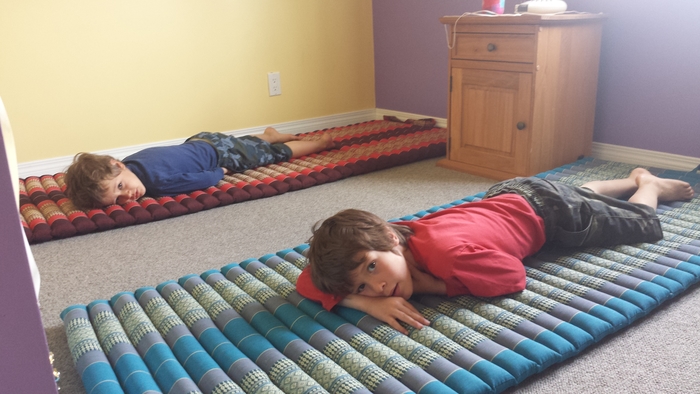
CBC North picked up on the post and published this article.
They also put a clip of our interview on TV and invited me in to our local morning radio show. And it was shared nationally via the CBC News Facebook page. Wow! I had no idea our unusual-for-North-America lifestyle would generate so much interest – cool!
With any story of something “different” that hits the media there is often some confusion in the public reaction.
“Interesting but I’m too old to do that.”
“If I didn’t have a bad back maybe I would try that.”
“Hmm, I like the idea of getting more movement, but do I really need to get rid of my furniture?”
“I move all day for work, I don’t need to move at home too.”
This blog post is a response to help break it down, explain why our already-active family feels the need to get more movement at home, and make the idea of incorporating more movement into one’s day-to-day lifestyle more accessible regardless of how you feel about your furniture. Because, let’s face it, no matter where you land on the age, mobility, or cultural norm scale, we can all benefit from increasing our day-to-day movement time, frequency and variability.
Because I’m a movement educator that teaches restorative exercise (exercise that helps prepare people’s bodies for whole-body natural movement), moving towards furniture-free was not that big a deal for our family. And it certainly was not the first step! Read on to get some ideas of simple things you can do to get more movement throughout your day without getting rid of your furniture.
The Rationale for More Movement that Led to Our Family’s “Furniture-Free” Decision
Right now here in North America we live in a very sedentary culture. More sedentary than ever before. From within this culture it can be challenging to think objectively about our views of what is “normal” and what we consider an “active lifestyle.” Because “active lifestyle” is a relative term that only has meaning in the context of what we think of as a normal level of activity. And that normal level of activity, although it might be common amongst people here and now, might not be the normal of other people in other cultures or people living here a long time ago. So what we consider an “active lifestyle” could actually be considered quite sedentary by a different cultural or historical standard. You get me? I hope I haven’t lost you already.
Let’s consider how our ancestors may have moved and compare that against the current Canadian Physical Activity Guidelines for Adults (18-64) that help us define “active lifestyle”.
The modern culture of chair-sitting (desk, dining room table, car, couch, etc.) for most of the day is relatively new on an evolutionary time scale. For thousands of years humans moved in their environment everyday for the purposes of finding food, clothing and shelter. Like other animals we evolved to move. And while modern medicine and sanitary practices have afforded us many health gains and an increased lifespan, these have occurred simultaneously with declines in many other health indicators, as we became a more sedentary species. Most of us no longer need to forage to find food, clothing and shelter. We no longer have a biological need to move.
So exercise guidelines were created, to keep us healthy, since we were no longer moving for a purpose. The Canadian Physical Activity Guidelines provided by CSEP (Canadian Society for Exercise Physiology) currently state:
“To achieve health benefits, adults aged 18-64 years should accumulate at least 150 minutes of moderate- to vigorous-intensity aerobic physical activity per week, in bouts of 10 minutes or more. It is also beneficial to add muscle and bone strengthening activities using major muscle groups, at least 2 days per week. More physical activity provides greater health benefits”
No minutes guidelines on the muscle and bone strengthening advice, let’s consider they mean 30 minutes twice a week. So 60 minutes muscle and bone-strengthening. Add that to 150 minutes of moderate-vigorous aerobic activity and we get a total of 210 minutes/week of exercise as the minimum guideline. That’s 3.5 hours of exercise a week or 30 minutes/day. Or a little less than 2 minutes/hour of your waking hours. Interesting.
Yet when our ancestors had a purpose to move, we can imagine that they moved:
- more overall (more than 30 minutes every day)
- moved more frequently (throughout the day rather than 30 minutes all at once)
- had more movement variability (movements that required different body positions);
- and, perhaps most importantly, had variability in resting positions (think no chairs)
Right?
If you take an animal out of the wild and give it these exercise guidelines from here on forward what do you think might happen to that animal’s musculoskeletal health and overall well-being? And generations later might the offspring of that animal have a different “normal” level of health?
This is not a critique of CSEP or their Guidelines. They are serving an important role in getting people more active during this very sedentary time.
I’m just pointing out that we sometimes forget where we came from and that makes it difficult to be objective about what we currently consider an “active lifestyle”.
But we have jobs. Responsibilities. Things we have to do that involve sitting. “What can we do about all of this?”
Well, we can start to think about how we can incorporate more movement and more variability of body positions into our everyday activities. That’s what.
And maybe all those other assumptions about being too old or that a bad back might prevent us from adopting more movement might just disappear if we start moving differently day-to-day. Maybe we don’t have to experience the “normal” decline in mobility with age or the “normal” increase in aches and pains. And if you already feel you’re in one of these categories, maybe by adopting a few small changes each day you might start to feel an improvement.
So that is the rationale for why our family is getting rid of our furniture. While we already sit on the floor often, removing one more barrier to moving our ankles, knees and hips in their full ranges of motion seemed the right thing to do. This decision has come after many years of taking many smaller steps in this direction. And after seeing the results of these smaller changes on our bodies. I healed my post-childbirth pelvic floor dysfunction through shifting how I move throughout the day rather than practicing isolated pelvic floor contractions (“kegels”) or having surgery. My partner Marc, a competitive runner in his youth, has improved his mobility and decreased his general aches and pains.
And by furniture, of course we are talking about furniture that prevents our bodies from moving through the full range of motion to get down and up from the floor. We are keeping cabinets, bookshelves and furniture for the purposes of organization. Thank goodness!
And one more clarification. Chairs are not the problem. Sitting is not really the new smoking. The human body is designed for a variety of positions requiring a variety of joint angles. Sitting in a chair represents one shape the human body is designed for. The problem arises when we sit in chairs for 6, 8, perhaps 10 or more hours/day with the absence of all the other potential body positions that goes along with that. Positions that would keep our joints and muscles healthy. Positions that might prevent the mobility restrictions that we associate with aging. Positions that might keep us feeling well.
Ok, FINALLY, here are the Goods:
21 Simple Things You Can Start Doing Today to Increase Your Day-to-Day Movement
(without adding extra time for exercise and without getting rid of your furniture)
- Start with the Feet!
Your feet support the rest of you. If they hurt or don’t move well, you are more likely to avoid movement overall. If they aren’t moving well it is also likely that other joints (knees, hips, etc.) will be affected.
If you live in Yellowknife, you can always come to my Healthy Feet Workshop that I run a few times/year for more exercises and ideas. Here are a couple of ideas you can start right away to improve the health of your feet.
Evaluate your footwear. Does it elevate your heel (putting more pressure on the small bones of your forefoot) or squish your toes together? Ouch! Find footwear that doesn’t do those things.
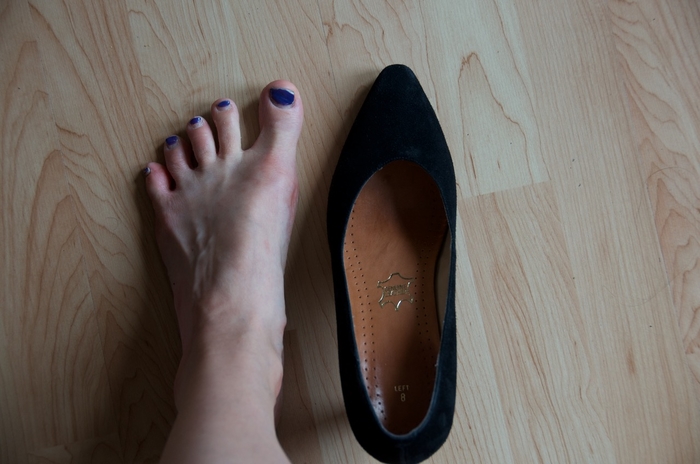
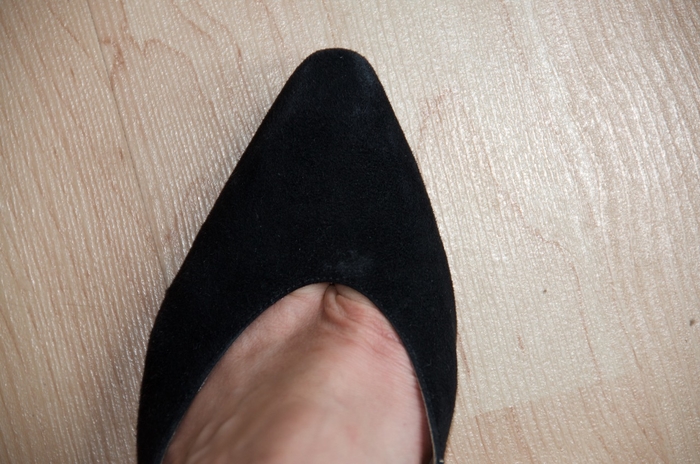 Look at that squish!
Look at that squish!
Go barefoot once in a while, even if it’s just around the house. Let your feet feel the earth and let the 33 joints in each foot respond to the texture of the ground.
- Change how you get up and down out of your chair. Use your glute and hamstring muscles instead of always loading your knees.
- Try getting right down to sit on the floor every time you take your shoes off or put them on. If this is a challenge, start by seeing if you can sit on something a little lower than a chair and work your way down.
- Always drive to work? Start parking 2 or 3 blocks further away and walk.
- Always bike? Increase your movement variability by switching it up and walking from time to time.
- Work at a desk? See if your employer will allow you to purchase a sit-stand desk so that you can vary your position more throughout the day.
- Play with your kids. On the floor. Watch what they do and then try it.
- Crawl into bed instead of sitting on the bed and swinging your legs up.
- Squat to pick something up instead of bending forward. Can’t squat? Practice #2 regularly.
- Waiting in line? Try to stand on one leg while you wait (think “pelvic list”). Then try the other leg.
- Change up your kitchen organization. Put the things you use most often in the lowest cupboards instead of having them accessible from standing upright. Now squat every time you have to get them.
- Try sitting on a cushion around the coffee table for a meal and see how you like it.
- Preparing food? Come down to the floor once in a while to do it. Here’s me clearing off the dehydrator trays before a recent canoe trip:
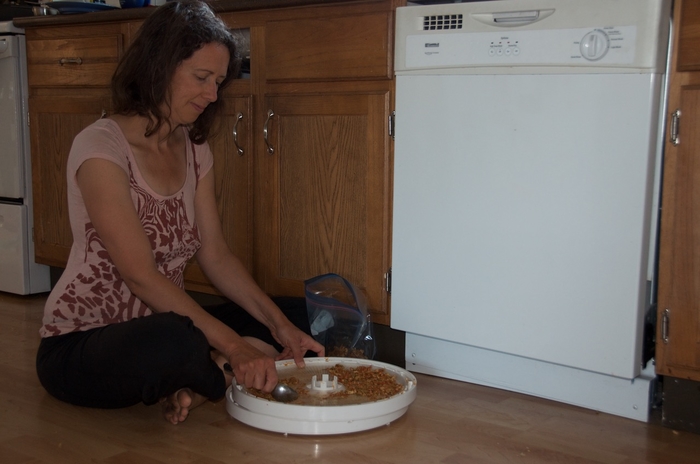
- Need to go get something from a different room in your house? Change up how you get there. Use your kids ideas from #7. Other ideas:
- Crawl
- Lunge walk
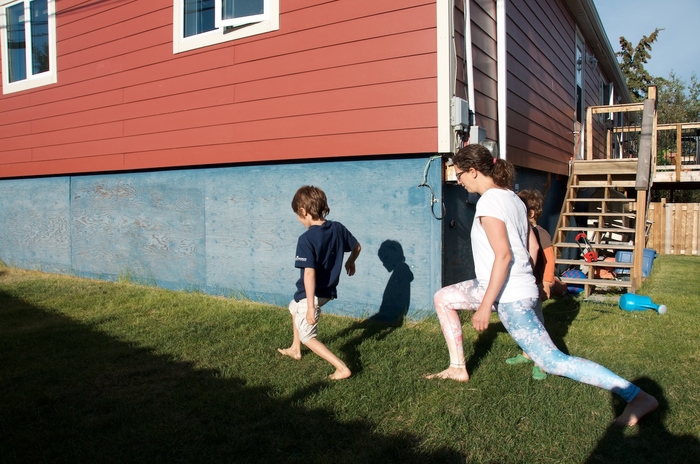
- At the playground with your kids? That equipment is not just for kids
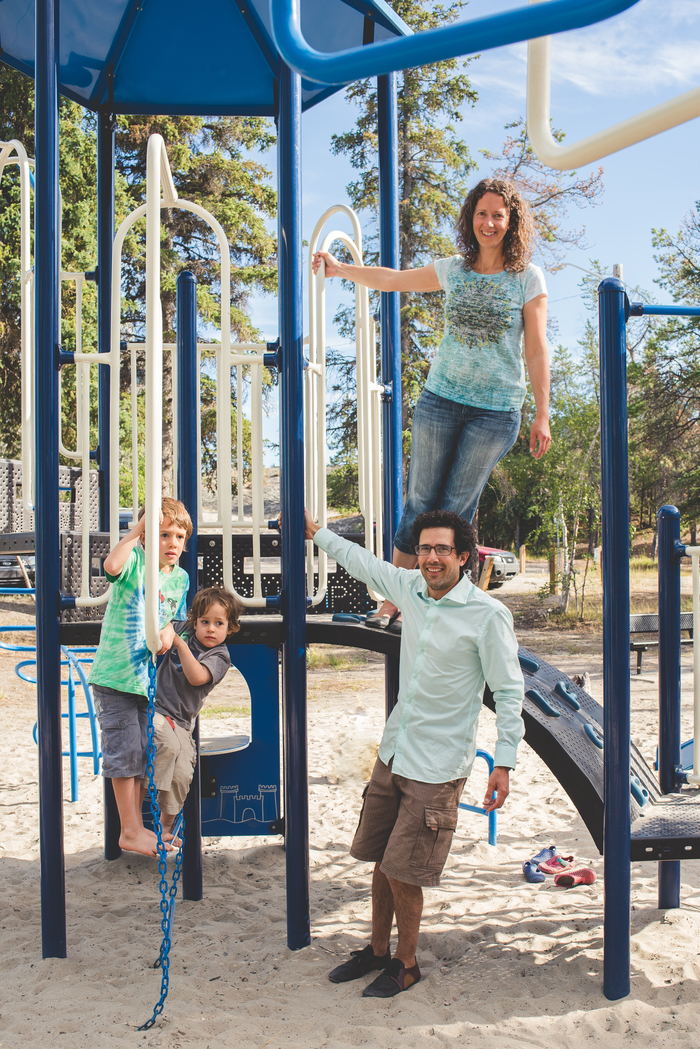
- Carry a shoulder bag? Try carrying it on the opposite shoulder. Or switch it up and try a backpack sometimes. Or carry it in your arms in front of you.
- Work from home (or in an office with enough space)? Try taking the laptop to the floor. It’s OK to be uncomfortable after 5 minutes. Change positions frequently or go back to your desk and try for 6 minutes next time. Here are some ideas:

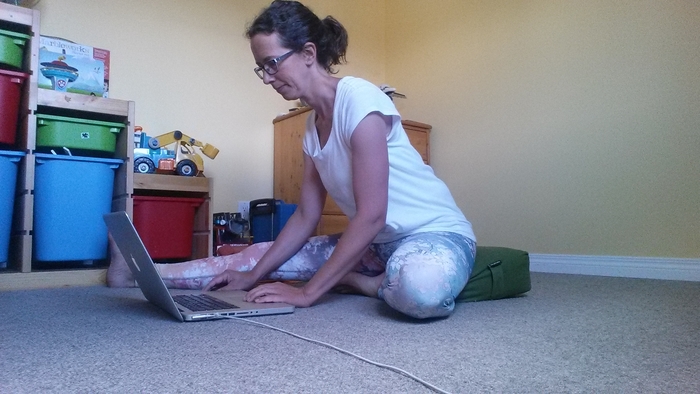
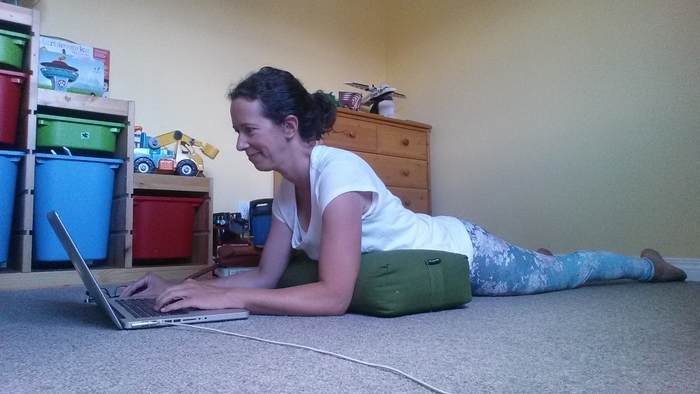
- Watching TV? Try taking the cushions off the sofa and sit lower to the ground.
- Take the stairs instead of the elevator at work.
- Going up stairs? Try two at a time. Or 3 if your size allows. Then mix it up so that with each step you take a different number of stairs.
- Going camping? Observe the way you move to navigate your camping experience. Then see if you can bring some of that movement home with you.
They might seem benign but these simple ideas all involve you moving your body in different ways than you might be used to. The smallest shifts can yield the biggest results. Try some of these and then send me a message about your experience! Have fun!


